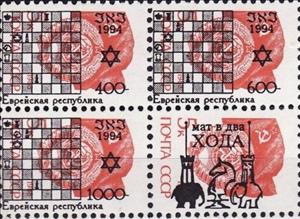Se-tenant: Chess (Cinderellas 1994)
Chess (Cinderellas 1994)
01 January (Cinderellas ) within release Russia : Jewish Autonomous Oblast goes into circulation Se-tenant Chess face value 2,000 Russian ruble
| Se-tenant Chess in catalogues | |
|---|---|
| Colnect codes: | Col: RU-YEV 1994-05 |
Se-tenant is square format.
Also in the issue Russia : Jewish Autonomous Oblast:
- Se-tenant - Chess face value 2,000;
- Se-tenant - Horses face value 6,800;
- Se-tenant - Horses face value 6,800;
- Se-tenant - Horses face value 6,800;
- Se-tenant - Overprint Jewish republic face value 800;
- Se-tenant - Overprint Jewish republic face value 1,000;
- Se-tenant - Overprint Jewish republic face value 1,700;
- Se-tenant - Overprint Jewish republic face value 2,300;
- Se-tenant - Overprint Jewish republic face value 2,800;
- Se-tenant - Overprint Jewish republic face value 7,000;
- Se-tenant - Overprint Jewish republic face value 7,000;
- Se-tenant - Overprint Jewish republic face value 7,000;
- Se-tenant - Dogs face value 5;
|
Data entry completed
50%
|
|
|---|---|
| Se-tenant Chess in digits | |
| Country: | Cinderellas |
| Date: | 1994-01-01 |
| Print: | Recess |
| Emission: | Cinderella |
| Format: | Se-tenant |
| Face Value: | 2,000 Russian ruble |
Se-tenant Chess it reflects the thematic directions:
Chess is usually played by two players (called chess players) against each other. It is also possible for one group of chess players to play against another or against one player; such games are often called consultation games. In addition, there is the practice of simultaneous play sessions, when several opponents play against one strong player, each on a separate board.
The rules of the game were basically developed by the 15th century; In modern official tournaments, the rules of the International Chess Federation[6] are applied, which regulate not only the movement of pieces, but also the rights of the judge, the rules of behavior of players and time control. A game played remotely - for example, by correspondence, by telephone or via the Internet - has special rules. There are many variants of chess that differ from classical ones: with non-standard rules, pieces, board sizes, etc. The corresponding section of chess composition is fairy chess. Some aspects of the game of chess are studied in mathematics (for example, the classic “Knight's Move Problem” and “Eight Queens Problem”), including through computer simulation. Chess is usually played by two players (called chess players) against each other. It is also possible for one group of chess players to play against another or against one player; such games are often called consultation games. In addition, there is the practice of simultaneous play sessions, when several opponents play against one strong player, each on a separate board.
The rules of the game were basically developed by the 15th century; In modern official tournaments, the rules of the International Chess Federation[6] are applied, which regulate not only the movement of pieces, but also the rights of the judge, the rules of behavior of players and time control. A game played remotely - for example, by correspondence, by telephone or via the Internet - has special rules. There are many variants of chess that differ from classical ones: with non-standard rules, pieces, board sizes, etc. The corresponding section of chess composition is fairy chess. Some aspects of the game of chess are studied in mathematics (for example, the classic “Knight's Move Problem” and “Eight Queens Problem”), including through computer simulation.
A coat of arms is an heraldic visual design on an escutcheon (i.e. shield), surcoat, or tabard. The coat of arms on an escutcheon forms the central element of the full heraldic achievement which in its whole consists of shield, supporters, crest, and motto. A coat of arms is traditionally unique to an individual person, family (except in the United Kingdom), state, organisation or corporation.


